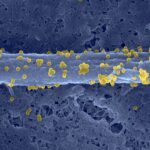Lien vers Pubmed [PMID] – 41038831
Lien DOI – 10.1038/s41572-025-00654-x
Nat Rev Dis Primers 2025 Oct; 11(1): 71
Listeriosis is a serious food-borne bacterial infection caused by Listeria monocytogenes. L. monocytogenes is a facultative intracellular bacterial species that can replicate inside human cells, as well as thrive in a variety of environments, including soil, decaying vegetation, animal intestines and foods such as unpasteurized dairy products, soft cheese, raw meat, fish, seafood, vegetables and fruits. Clinically, L. monocytogenes can cause gastroenteritis in healthy individuals or serious invasive infections in at-risk populations. For example, maternal-fetal infections during pregnancy can lead to adverse pregnancy outcomes. In the elderly and immunosuppressed, listeriosis can cause septicaemia and central nervous system infections (also known as neurolisteriosis) with high mortality and risk of long-term sequelae. Genomic studies have identified four lineages of L. monocytogenes, with lineage I comprising the most virulent strains. The pathogenicity of L. monocytogenes reflects its ability to resist gastric and bile acids, colonize the intestinal lumen, cross the intestinal barrier, survive intracellularly in the bloodstream, evade immune responses, and cross the placental and blood-brain barriers. Diagnosis of listeriosis (septicaemia, neurolisteriosis, maternal-neonatal listeriosis or focal listeriosis) involves clinical observations and microbiological testing based on bacterial culture or DNA detection in individuals with prior antimicrobial therapy. Treatment typically involves aminopenicillins and aminoglycosides, with no evidence of clinically meaningful acquired antimicrobial resistance. Although listeriosis is a well-studied infection, a clearer picture of its global burden, its pathophysiology, the dynamics of the L. monocytogenes population and transmission routes is needed. On the host side, new risk factors, including genetics, and new treatment regimens to improve patient outcomes need to be identified.

